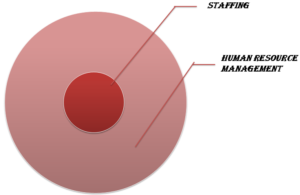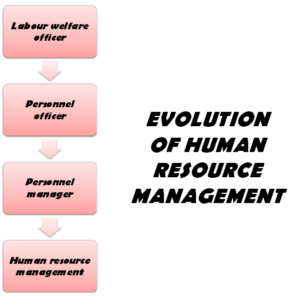Staffing as a Part of Human Resource Management talks how Human resource is an essential element of any organization as human resources put the plan into action. Staffing as a part of Human Resource Management can be said true, all the points supporting the statement are given below.
Staffing as a Part of Human Resource Management (HRM) Class 12 Notes Business Studies
Human resource management: Human resource management is a broad term. It is a strategic approach towards the management of human resources of an organization so to gain a competitive advantage. It includes a broad gamut of activities such as employing human resource, their payment, compensation, developing policies related to them, training and their development, forming strategies to retain them etc.
Where staffing in human resource management is just a part of human resource management. After organizing the business and framing different positions, it becomes important and obligatory to fill those positions so that people can work and then further functions can take place. Thus, staffing in human resource management involves estimating the manpower requirements, and then their recruitment, selection and placement take place. Then it is time for their training and development.
Staffing as a function involves the human element which is very important to deal with. Humans cannot be considered the same as other resources of an organization. Other resources are predictable, but humans are not. Humans are dynamic. The main difference comes from their ability to perform better when motivated and encouraged. Thus, the success of a business organization also depends upon the way they are motivated, encouraged, trained, developed, their competence, their skills and finally their performance.
Staffing as a part of Human Resource Management

Size of the organization : Staffing as a part of Human Resource Management largely depends on the size of an organization. When an organization is small, then the managers may themselves perform all the tasks which are required to manage the human resource of an organization. But when the organizational size increases, then there is a separate department that is established, called the human resource department. It includes the managers and the specialists who deal with humans and their behaviour for the betterment of an organization. Human resource management is no doubt a specialised area and thus requires specialists to deal with it. When the size of the human resource department is large then it is clear that the organization runs on a large basis.
Duties of Human Resource Management Department
Some of the duties of the human resource management department are as under:
Recruitment under Staffing as a Part of Human Resource Management
It is the first and foremost step in managing human resources. It is a step which involves searching for people. Wherein, the right kinds of people are required for the right job. Thus, a job description is prepared and it is advertised through various written, oral and digital platforms so that people looking for the same kind of job can apply.
Analysing jobs
Before getting the people on board, it is important to have a distinction of the role and responsibility the person will be handling. It needs to be specified in the job description so that it does not create any chaos later on.
Developing compensation/incentive plans
It is a very important part or function in human resource management. When any resource is used, there is a certain payment to be done against it. Similarly, humans are also a resource for an organization and thus they need to be paid. Moreover, to keep them motivated, incentives and bonuses are also paid and this is a function of a human resource manager to prepare the plans accordingly.
Training and development under Staffing as a Part of Human Resource Management
Training and development is a very important part of human resource management. Every employee has certain skills but they need to be updated with the changing environment. Training an employee becomes important to improve the overall performance of an organization and to achieve its goals. It is also important from the eyes of an employee because it helps them to gain various skills and also in career growth.
Maintaining labour relations under Staffing as a Part of Human Resource Management
There are various relationships in an organization including the superior-subordinate relationship, employee-to-employee relationship, labour union, etc. It becomes crucial for a human resource manager to deal with these relationships so that they help in the overall growth of the firm. They should not be unproductive and should not involve a waste of time and effort 6any person. Also, maintaining good communication with the workers and labourers helps in keeping them motivated and satisfied.
Handling complaints and grievances
Not a single organization is perfect. It becomes important for the manager to deal with the negative elements in an organization. Complaints and grievances are part of it. Handling them properly, so to keep a balance, between the organizational needs and individual employee needs.
Welfare of employees under Staffing as a Part of Human Resource Management
There are different functions in an organization such as marketing, financing, handling operations etc. handling human resources is a different kind of function as it involves the human element. When humans are considered then their needs, wants, goals, behaviour etc. are also considered. They should be given importance as they are the ones who perform the tasks and help in achieving the goals of any organization. Their welfare should be the utmost priority and for this human resource manager works on different policies and rules, so that they can benefit the organization and the workers in a balanced way.
Avoiding legal complications
When there are any legal complications in an organization, if any, then it becomes important for the manager along with the human resource manager to work for it so that they can defend the company in lawsuits.
Evolution of human resource management

Labour welfare officer
During the time of industrial revolution and after the trade union movement which was for the purpose of overall welfare of the workers by collective bargaining for the improvement in pay, working conditions, security of job, social status and benefits etc., it became important for any organization to have a person who can work for the welfare of the employees and thus companies started appointing a person who was called labour welfare officer.
Personnel officer under Staffing as a Part of Human Resource Management
After this, when the companies started to grow in size and operations, it became important to appoint many employees and labourers under one roof and thus it became difficult to manage them. Thus, a personnel officer was appointed to manage people and alter on they were called personnel managers.
Human resource managers
It did not stop over there. The environment was changing regularly and technological gradation became common thus it became important for the organization to develop and train the employees so that they can have a union of efforts and direction and help in achieving the goals of an organization.
Giving more importance to human resources in an organization is becoming an important trend and it is very crucial to retain the employees in an organization thus human resource department came into being.
Human resource management has thus evolved over time and came from labour welfare and personnel management and it includes various activities some of the activities of human resource management are a part of staffing and that is why it is called a part of a broad category of human resource management.
Conclusion
Staffing is a function of management just like planning, organizing, directing and controlling. It is also an activity like marketing, financial management and operations. That is why staffing in human resource management is called both a line and staff activity.
Chapter 6 – Staffing
- Need and Importance of Staffing
- Staffing as a part of Human resource
- Introduction to recruitment
- Training and development